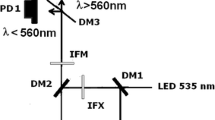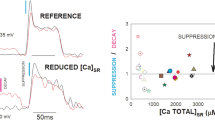Summary
Addition of fragmented sarcoplasmic reticulum (SR) vesicles to the aqueous phase of a black lipid membrane (BLM) causes a large increase in BLM conductance within 10 min. The conductance increase is absolutely dependent on three conditions: The presence of at least 0.5mm Ca++, an acidic phospholipid such as phosphatidylserine or diphosphatidylglycerol in the BLM phospholipid mixture, and an osmotic gradient across the SR vesicle membrane, with the internal osmolarity greater than the external. These requirements are identical to conditions under which the fusion of phospholipid vesicles occurs.
When the early part of the time course of conductance rise is examined at high sensitivity, the conductance is seen to increase in discrete steps. The probability of a step increases with the concentration of Ca++ in the medium, with the fraction of acidic phospholipid in the BLM, and with the size of the osmotic gradient across the SR vesicle membrane. On the other hand, the average conductance change per step is independent of the above parameters, but varies with the type and concentration of ions present in the aqueous phase. For a given ion, the mean specific conductance per step is independent of the ion's concentration between 10 and 100mm.
The probability distribution of the step-conductances agrees well with the distribution of SR vesicle surface areas, both before and after sonication of the vesicles.
The evidence indicates that SR vesicles fuse with the BLM, thereby inserting SR membrane conductance pathways into it. Each discrete conductance jump appears to be the result of the fusion of a single SR vesicle with the BLM. This technique may serve as a general method for inserting membrane vesicles into an electrically accessible system.
Similar content being viewed by others
References
Bradley, R.J., Howell, J.H., Romine, W.O., Carl, G.R., Kemp, G.E. 1976. Characterization of a nicotinic acetylcholine receptor from rabbit skeletal muscle and reconstitution in planar phospholipid bilayers.Biochem. Biophys. Res. Commun. 68:577
Constantin, L.L., Podolsky, R.J. 1966. Evidence for depolarization of the internal membrane system in activation of frog sartorius muscle.Nature (London) 210:483
Constantin, L.L., Podolsky, R.J. 1967. Depolarization of the internal membrane system in the activation of frog skeletal muscle.J. Gen. Physiol. 50:1101
Drachev, L.A., Jasaitis, A.A., Kaulen, A.D., Kondrashin, A.A., Liberman, E.A., Nemecek, I.B., Ostroumov, S.A., Semenov, A.Yu., Skulachev, V.P. 1974. Direct measurement of electric current generation by cytochrome oxidase, H+-ATPase, and bacteriorhodopsin.Nature (London) 249:321
Duggan, P.F., Martonosi, A.N. 1970. Sarcoplasmic reticulum. IX. The permeability of sarcoplasmic reticulum membranes.J. Gen. Physiol. 56:147
Ebashi, S. 1976. Excitation-contraction coupling.Annu. Rev. Physiol. 38:293
Ebashi, S., Endo, M. 1968. Calcium ion and muscle contraction.Prog. Biophys. Mol. Biol. 18:123
Haydon, D.A., Hladky, S.B. 1972. Ion transport across thin lipid membranes: A critical discussion of mechanisms in selected systems.Quart Rev. Biophysics 5:187
Jilka, R.L., Martonosi, A.N., Tillack, T.W. 1975. Effect of purified (Ca+2+Mg+2)-activated ATPase of sarcoplasmic reticulum upon the passive permeability and ultrastructure of phospholipid vesicles.J. Biol. Chem. 250:7511
Kagawa, Y., Kandrach, A., Racker, E. 1973. Partial resolution of the enzymes catalyzing oxidative phosphorylation. XXVI. Specificity of phospholipids required for energy transfer reaction.J. Biol. Chem. 248:676
Kasai, M., Miyamoto, H. 1973. Depolarization-induced calcium release from SR membrane fragments by changing ionic environments.FEBS Lett. 34:299
MacLennan, D.H. 1970. Purification and properties of an adenosine triphosphatase from sarcoplasmic reticulum.J. Biol. Chem. 245:4508
Meissner, G. 1975. Isolation and characterization of two types of sarcoplasmic reticulum vesicles.Biochim. Biophys. Acta 389:51
Miller, C., Arvan, P., Telford, J.N., Racker, E. 1976. Ca++-induced fusion of proteoliposomes. Dependence on transmembrane osmotic gradient.J. Membrane Biol. 30:
Miller, C., Racker, E. 1976. Fusion of phospholipid vesicles reconstituted with cytochromec oxidase and mitochondrial hydrophobic protein.J. Membrane Biol. 26:319
Montal, M., Mueller, P. 1972. Formation of bimolecular membranes from lipid monolayers and a study of their electrical properties.Proc. Nat. Acad. Sci. USA 69:3561
Mueller, P. 1975. Electrical excitability in lipid bilayers and cell membranes.In: Energy Transducing Mechanisms. E. Racker, editor. Vol. 3, pp. 75–120. MTP International Review of Science, Butterworths, University Park Press, Baltimore
Mueller, P., Rudin, D.O. 1969a. Bimolecular lipid membranes. Techniques of formation, study of electrical properties, and induction of ionic gating phenomena.In: Laboratory Techniques in Membrane Biophysics. H. Passow and R. Stämpfli editors. pp. 141–156. Springer-Verlag, Berlin
Mueller, P., Rudin, D.O. 1969b. Translocators in bimolecular lipid membranes: Their role in dissipative and conservative energy transductions.In: Current Topics in Bioenergetics. D.R. Sanadi, editor. Vol. 3, pp. 157–249. Academic Press, New York
Nakajima, Y., Endo, M. 1973. Release of calcium induced by “depolarization” of the sarcoplasmic reticulum membrane.Nature New Biol. 246:216
Owens, K., Ruth, R.C. Weglicki, W.B. 1972. Lipid composition of purified fragmented sarcoplasmic reticulum of the rabbit.Biochim. Biophys. Acta 288:479
Papahadjopoulos, D., Miller, N. 1967. Phospholipid model membranes. I. Structural characteristics of hydrated liquid crystals.Biochim. Biophys. Acta 135:624
Papahadjopoulos, D., Poste, G., Schaeffer, B.E., Vail, W.J. 1974. Membrane fusion and molecular segregation in phospholipid vesicles.Biochim. Biophys. Acta 352:10
Sandow, A. 1970. Skeletal Muscle.Annu. Rev. Physiol. 32:87
Shamoo, A.E., Eldefrawi, M.E. 1975. Carbamylcholine and acetylcholine-sensitive, cation-selective ionophore as part of the purified acetylcholine receptor.J. Membrane Biol. 25:47
Shamoo, A.E., MacLennan, D.H. 1974. A Ca++-dependent and selective ionophore as part of the Ca+++Mg++-dependent adenosinetriphosphatase of sarcoplasmic reticulum.Proc. Nat. Acad. Sci. USA 71:3522
Thorens, S., Endo, M. 1975. Ca+2-induced Ca+2 release and “depolarization” induced Ca+2 release: their physiological significance.Proc. Jpn. Acad. 51:473
Weber, A., Murray, J.M. 1972. Molecular control mechanisms in muscle contraction.Physiol. Rev. 53:612
Author information
Authors and Affiliations
Rights and permissions
About this article
Cite this article
Miller, C., Racker, E. Ca++-induced fusion of fragmented sarcoplasmic reticulum with artificial planar bilayers. J. Membrain Biol. 30, 283–300 (1976). https://doi.org/10.1007/BF01869673
Received:
Issue Date:
DOI: https://doi.org/10.1007/BF01869673




